The Conservation Varieties Regime: Its Past, Present and Future in the Protection and Commercialisation of Vegetable Landraces in Europe
Abstract
1. Introduction
2. Methodology
3. Results
3.1. The European CC and CVR Scenario
3.2. The Evolution of the CVR in Europe
3.3. Case Study: Analysis of Italian CVR Registrations
4. Discussion
5. Conclusions
Supplementary Materials
Author Contributions
Funding
Data Availability Statement
Conflicts of Interest
Appendix A
| Waiver | Legislative Indication |
|---|---|
| Conservation Varieties (CVR) |
|
| Varieties developed for growing under particular conditions (VDPC) |
|
References
- De Jonge, B.; López Noriega, I.; Otieno, G.; Cadima, X.; Terrazas, F.; Hpommalath, S.; Van Oudenhoven, F.; Shrestha, S.; Pudasaini, N.; Singh Shrestha, D.; et al. Advances in the Registration of Farmers’ Varieties: Four Cases from the Global South. Agronomy 2021, 11, 2282. [Google Scholar] [CrossRef]
- Elia, A.; Santamaria, P. Biodiversity in Vegetable Crops, a Heritage to Save: The Case of Puglia Region. Ital. J. Agron. 2013, 8, 4. [Google Scholar] [CrossRef]
- Khoury, C.K.; Brush, S.; Costich, D.E.; Curry, H.A.; De Haan, S.; Engels, J.M.M.; Guarino, L.; Hoban, S.; Mercer, K.L.; Miller, A.J.; et al. Crop Genetic Erosion: Understanding and Responding to Loss of Crop Diversity. New Phytol. 2022, 233, 84–118. [Google Scholar] [CrossRef] [PubMed]
- Negri, V.; Maxted, N.; Veteläinen, M. European Landraces Conservation: An Introduction. In European Landraces: On-Farm Conservation, Management and Use; Veteläinen, M., Negri, V., Maxted, N., Eds.; Biodiversity Technical Bulletin No. 15; Biodiversity International: Rome, Italy, 2009; ISBN 978-92-9043-805-2. [Google Scholar]
- Pingali, P.L. Green Revolution: Impacts, Limits, and the Path Ahead. Proc. Natl. Acad. Sci. USA 2012, 109, 12302–12308. [Google Scholar] [CrossRef] [PubMed]
- Witcombe, J.R. Participatory Approaches to Plant Breeding and Selection. Biotechnol. Dev. Monit. 1996, 29, 26. [Google Scholar]
- Andersen, R. Information Paper on Farmers’ Rights Submitted by the Fridtjof Nansen Institute, Norway, Based on the Farmers’ Rights Project; Input Paper Submitted to the Secretariat of the Plant Treaty; (IT/GB-3/09/ Inf. 6 Add. 3); Fridtjof Nansen Institute: Lysaker, Norway, 2009. [Google Scholar]
- Visser, B. An Agrobiodiversity Perspective on Seed Policies. J. New Seeds 2002, 4, 231–245. [Google Scholar] [CrossRef]
- Food and Agriculture Organization of the United Nations. International Treaty on Plant Genetic Resources for Food and Agriculture; Food and Agriculture Organization of the United Nation: Rome, Italy, 2001. [Google Scholar]
- United Nations Environment Programme. Convention on Biological Diversity; United Nations Environment Programme: Montreal, QC, Canada, 1992. [Google Scholar]
- Osman, A.; Chable, V. Inventory of Initiatives on Seeds of Landraces in Europe. J. Agric. Environ. Int. Dev. 2009, 103, 95–130. [Google Scholar] [CrossRef]
- Louwaars, N.; De Jonge, B. Regulating Seeds—A Challenging Task. Agronomy 2021, 11, 2324. [Google Scholar] [CrossRef]
- European Council. Council Directive 98/95/CE of 14 December 1998 Amending, in Respect of the Consolidation of the Internal Market, Genetically Modified Plant Varieties and Plant Genetic Resources, Directives 66/400/EEC, 66/401/EEC, 66/402/EEC, 66/403/EEC, 69/208/EEC, 70/457/EEC and 70/458/EEC on the Marketing of Beet Seed, Fodder Plant Seed, Cereal Seed, Seed Potatoes, Seed of Oil and Fibre Plants and Vegetable Seed and on the Common Catalogue of Varieties of Agricultural Plant Species. 1998. Available online: https://eur-lex.europa.eu/legal-content/EN/TXT/PDF/?uri=CELEX:31998L0095 (accessed on 16 July 2024).
- Almekinders, C.J.M.; Louwaars, N.P. The Importance of the Farmers’ Seed Systems in a Functional National Seed Sector. J. New Seeds 2002, 4, 15–33. [Google Scholar] [CrossRef]
- Louwaars, N.P.; De Boef, W.S. Integrated Seed Sector Development in Africa: A Conceptual Framework for Creating Coherence Between Practices, Programs, and Policies. J. Crop Improv. 2012, 26, 39–59. [Google Scholar] [CrossRef]
- Louwaars, N.P. Seed Systems: Managing, Using and Creating Crop Genetic Resources. In Routledge Handbook of Agricultural Biodiversity; Hunter, D., Guarino, L., Spillane, C., McKeown, P.C., Eds.; Routledge Handbooks; Routledge: London, UK; New York, NY, USA, 2017; pp. 535–546. ISBN 978-1-317-75329-2. [Google Scholar]
- Lorenzetti, F.; Negri, V. The European Seed Legislation on Conservation Varieties. In European Landraces: On-Farm Conservation, Management and Use; Veteläinen, M., Negri, V., Maxted, N., Eds.; Biodiversity Technical Bulletin No. 15; Biodiversity International: Rome, Italy, 2009; ISBN 978-92-9043-805-2. [Google Scholar]
- Ministry of Agriculture, Food and Forestry. National Plan on Biodiversity of Agricultural Interest. 2008. Available online: https://www.mase.gov.it/sites/default/files/archivio/allegati/biodiversita/piano_nazionale_biodiversita_interesse_agricolo.pdf (accessed on 16 July 2024). (In Italian)
- Pimbert, M.P. Participatory Research and On-Farm Management of Agricultural Biodiversity in Europe; IIED: London, UK, 2011; ISBN 978-1-84369-809-8. [Google Scholar]
- European Commission. Commission Directive 2009/145/EC of 26 November 2009 Providing for Certain Derogations, for Acceptance of Vegetable Landraces and Varieties Which Have Been Traditionally Grown in Particular Localities and Regions and Are Threatened by Genetic Erosion and of Vegetable Varieties with No Intrinsic Value for Commercial Crop Production but Developed for Growing under Particular Conditions and for Marketing of Seed of Those Landraces and Varieties. 2009. Available online: https://eur-lex.europa.eu/LexUriServ/LexUriServ.do?uri=OJ:L:2009:312:0044:0054:EN:PDF (accessed on 16 July 2024).
- Frese, L.; Reinhard, U.; Bannier, H.; Germeier, C.U. Landrace Inventory in Germany—Preparing the National Implementation of the EU Directive 2008/62/EC. In European Landraces: On-Farm Conservation, Management and Use; Veteläinen, M., Negri, V., Maxted, N., Eds.; Biodiversity Technical Bulletin No. 15; Biodiversity International: Rome, Italy, 2009; ISBN 978-92-9043-805-2. [Google Scholar]
- Batur, F.; Bocci, R.; Bartha, B. Marketing Farmers’ Varieties in Europe: Encouraging Pathways with Missing Links for the Recognition and Support of Farmer Seed Systems. Agronomy 2021, 11, 2159. [Google Scholar] [CrossRef]
- Winge, T. Seed Legislation in Europe and Crop Genetic Diversity. In Sustainable Agriculture Reviews; Lichtfouse, E., Ed.; Springer International Publishing: Cham, Switzerland, 2015; Volume 15, pp. 1–64. ISBN 978-3-319-09131-0. [Google Scholar]
- Chable, V.; Thommens, A.; Goldringer, I.; Valero Infante, T.; Levillain, T.; Lammerts van Bueren, E. Report on the Definitions of Varieties in Europe, of Local Adaptation, and of Varieties Threatened by Genetic Erosion; Farm Seed Opportunities and the French National Institute for Agricultural Research (INRA): Paris, France, 2010. [Google Scholar]
- Louwaars, N.; Kik, C.; van Bueren, E.L. Matches and Mismatches of the 2008/62/EC Directive, Text, Practice, and Positions; Farm Seed Opportunities and the French National Institute for Agricultural Research (INRA): Paris, France, 2010. [Google Scholar]
- European Commission. Commission Staff Working Document. In Study on the Union’s Options to Update the Existing Legislation on the Production and Marketing of Plant Reproductive Material; SWD(2021) 90 Final; European Commission: Brussels, Belgium, 2021. [Google Scholar]
- European Commission. Proposal for a Regulation of the European Parliament and of the Council on the Production and Marketing of Plant Reproductive Material in the Union, Amending Regulations (EU) 2016/2031, 2017/625 and 2018/848 of the European Parliament and of the Council, and Repealing Council Directives 66/401/EEC, 66/402/EEC, 68/193/EEC, 2002/53/EC, 2002/54/EC, 2002/55/EC, 2002/56/EC, 2002/57/EC, 2008/72/EC and 2008/90/EC (Regulation on Plant Reproductive Material). 2023. Available online: https://eur-lex.europa.eu/resource.html?uri=cellar:02951036-1cac-11ee-806b-01aa75ed71a1.0001.02/DOC_1&format=PDF (accessed on 16 July 2024).
- Raggi, L.; Pacicco, L.C.; Caproni, L.; Álvarez-Muñiz, C.; Annamaa, K.; Barata, A.M.; Batir-Rusu, D.; Díez, M.J.; Heinonen, M.; Holubec, V.; et al. Analysis of Landrace Cultivation in Europe: A Means to Support in Situ Conservation of Crop Diversity. Biol. Conserv. 2022, 267, 109460. [Google Scholar] [CrossRef]
- European Parliament. European Parliament Legislative Resolution of 24 April 2024 on the Proposal for a Regulation of the European Parliament and of the Council on the Production and Marketing of Plant Reproductive Material in the Union, Amending Regulations (EU) 2016/2031, 2017/625 and 2018/848 of the European Parliament and of the Council, and Repealing Council Directives 66/401/EEC, 66/402/EEC, 68/193/EEC, 2002/53/EC, 2002/54/EC, 2002/55/EC, 2002/56/EC, 2002/57/EC, 2008/72/EC and 2008/90/EC (Regulation on Plant Reproductive Material) (COM(2023)0414—C9-0236/2023—2023/0227(COD)). 2024. Available online: https://www.europarl.europa.eu/doceo/document/TA-9-2024-0341_EN.pdf (accessed on 16 July 2024).
- European Commission. EUPVP—Common Catalogue Information System. Available online: https://ec.europa.eu/food/plant-variety-portal/ (accessed on 16 July 2024).
- Santamaria, P.; Signore, A. How Has the Consistency of the Common Catalogue of Varieties of Vegetable Species Changed in the Last Ten Years? Sci. Hortic. 2021, 277, 109805. [Google Scholar] [CrossRef]
- Legislative Decree No. 20 of 2 February 2021. Standards for the Production for Marketing Purposes and the Marketing of Seed Products in Implementation of Article 11 of Law No. 117 of 4 October 2019 for the Adaptation of National Legislation to the Provisions of Regulation (EU) 2016/2031 and Regulation (EU) 2017/625. 2021. Available online: https://www.gazzettaufficiale.it/eli/id/2021/02/27/21G00022/sg (accessed on 16 July 2024). (In Italian).
- Law No. 1096 of 25 November 1971. Regulation of Seed Business. 1971. Available online: https://www.gazzettaufficiale.it/eli/id/1971/12/22/071U1096/sg (accessed on 16 July 2024). (In Italian).
- Law No. 194 of 1 December 2015. Provisions for the Protection and Enhancement of Biodiversity of Agricultural and Food Interest. 2015. Available online: https://www.gazzettaufficiale.it/eli/id/2015/12/11/15G00210/sg%20 (accessed on 16 July 2024). (In Italian).
- Ministry of Agricultural Food and Forestry Policies. Ministerial Decree 12 November 2009. Determination of the Professional Requirements and the Minimum Equipment Necessary for the Exercise of the Activity of Production, Trade and Import of Plants and Plant Products. 2009. Available online: https://www.gazzettaufficiale.it/atto/serie_generale/caricaDettaglioAtto/originario?atto.dataPubblicazioneGazzetta=2010-03-23&atto.codiceRedazionale=10A03387&elenco30giorni=false (accessed on 16 July 2024). (In Italian).
- European Commission. Council Decision (EU) 2019/1905 of 8 November 2019 Requesting the Commission to Submit a Study on the Union’s Options to Update the Existing Legislation on the Production and Marketing of Plant Reproductive Material, and a Proposal, If Appropriate in View of the Outcomes of the Study. 2019. Available online: https://eur-lex.europa.eu/legal-content/EN/TXT/PDF/?uri=CELEX:32019D1905 (accessed on 16 July 2024).
- European Commission; Directorate General for Health and Food Safety; ICF. Data Gathering and Analysis to Support a Commission Study on the Union’s Options to Update the Existing Legislation on the Production and Marketing of Plant Reproductive Material: Final Report; Publications Office: Luxembourg, 2021. [Google Scholar]
- Santamaria, P.; Ronchi, L. Varietà da Conservazione in Italia: Lo Stato dell’arte per le Specie Orticole. Italus Hortus 2016, 23, 29–44. (In Italian) [Google Scholar]
- FAOSTAT Vegetable Production in Europe in 2021. Available online: https://www.fao.org/faostat (accessed on 16 July 2024).
- Camanzi, L.; Malorgio, G.; Azcárate, T.G. The Role of Producer Organizations in Supply Concentration and Marketing: A Comparison between European Countries in the Fruit and Vegetable Sector. J. Food Prod. Mark. 2011, 17, 327–354. [Google Scholar] [CrossRef]
- Spanò, R.; Mascia, T.; Kormelink, R.; Gallitelli, D. Grafting on a Non-Transgenic Tolerant Tomato Variety Confers Resistance to the Infection of a Sw5-Breaking Strain of Tomato Spotted Wilt Virus via RNA Silencing. PLoS ONE 2015, 10, e0141319. [Google Scholar] [CrossRef] [PubMed]
- Spanò, R.; Ferrara, M.; Gallitelli, D.; Mascia, T. The Role of Grafting in the Resistance of Tomato to Viruses. Plants 2020, 9, 1042. [Google Scholar] [CrossRef] [PubMed]
- Mastrochirico, M.; Spanò, R.; Mascia, T. Grafting to Manage Infections of the Emerging Tomato Leaf Curl New Delhi Virus in Cucurbits. Plants 2022, 12, 37. [Google Scholar] [CrossRef] [PubMed]
- Bocci, R. Seed Legislation and Agrobiodiversity: Conservation Varieties. J. Agric. Environ. Int. Dev. 2009, 103, 31–49. [Google Scholar] [CrossRef]
- Bocci, R. Search of Conservation Varieties; 21st Newsletter of the Rural Seed Network; Rete Semi Rurali: Scandicci, Italy, 2019. [Google Scholar]
- Apulia Region. Regional Law 11 December 2013, n. 39. Protection of Native Genetic Resources of Agricultural, Forestry and Zootechnical Interest (Published in Official Bulletin of the Apulia Region n. 166 of 17 December 2013). 2013. Available online: https://biodiversitapuglia.it/wp-content/uploads/2014/05/B.U.R.P.-n.166-del-17122013.pdf (accessed on 16 July 2024). (In Italian).
- Didonna, A.; Renna, M.; Santamaria, P. Traditional Italian Agri-Food Products: A Unique Tool with Untapped Potential. Agriculture 2023, 13, 1313. [Google Scholar] [CrossRef]
- Ministerial Decree n. 350 of 8 September 1999. Regulation Containing Rules for the Identification of Traditional Products Pursuant to Article 8, Paragraph 1, of Legislative Decree n. 173 of 30 April 1998 (Published in the Official Journal n. 240 of 12 October 1999). 1999. Available online: https://www.gazzettaufficiale.it/eli/id/1999/10/12/099G0423/sg (accessed on 16 July 2024). (In Italian).
- Council of the European Union. Proposal for a Regulation of the Parliament and of the Council on the Production and Marketing of Plant Reproductive Material in the Union, Amending Regulations (EU) 2016/2031, 2017/625 and 2018/848 of the European Parliament and of the Council, and Repealing Council Directives 66/401/EEC, 66/402/EEC, 68/193/EEC, 2002/53/EC, 2002/54/EC, 2002/55/EC, 2002/56/EC, 2002/57/EC, 2008/72/EC and 2008/90/EC (Regulation on Plant Reproductive Material)—State of Play. 2024. Available online: https://data.consilium.europa.eu/doc/document/ST-11142-2024-INIT/en/pdf (accessed on 16 July 2024).
- Seedword.com. European Parliament’s PRM Report Is a Worrying Step Backwards for EU’s Agricultural Future. 2024. Available online: https://www.seedworld.com/europe/2024/04/25/european-parliaments-prm-report-is-a-worrying-step-backwards-for-eus-agricultural-future/ (accessed on 26 June 2024).
- Bocci, R. The Diversity Breaks in Brussels. Altraeconomia, 2024, 271. Available online: https://altreconomia.it/la-diversita-irrompe-a-bruxelles/ (accessed on 26 June 2024). (In Italian).
- Liberatediversity.org. Results of the European Parliament Vote on Plant Reproductive Materials. 2024. Available online: https://liberatediversity.org/results-of-the-european-parliament-vote-on-plant-reproductive-materials/ (accessed on 26 June 2024).
- Sanchez Manzanaro, S.; Di Mambro, A.; Radosavljevic, Z. EU Agriculture MEPs Vote to Exempt ‘Old Varieties’ from Seed Marketing Rules. 2024. Available online: https://www.euractiv.com/section/agriculture-food/news/eu-agriculture-meps-vote-to-exempt-old-varieties-from-seed-marketing-rules/ (accessed on 26 June 2024).
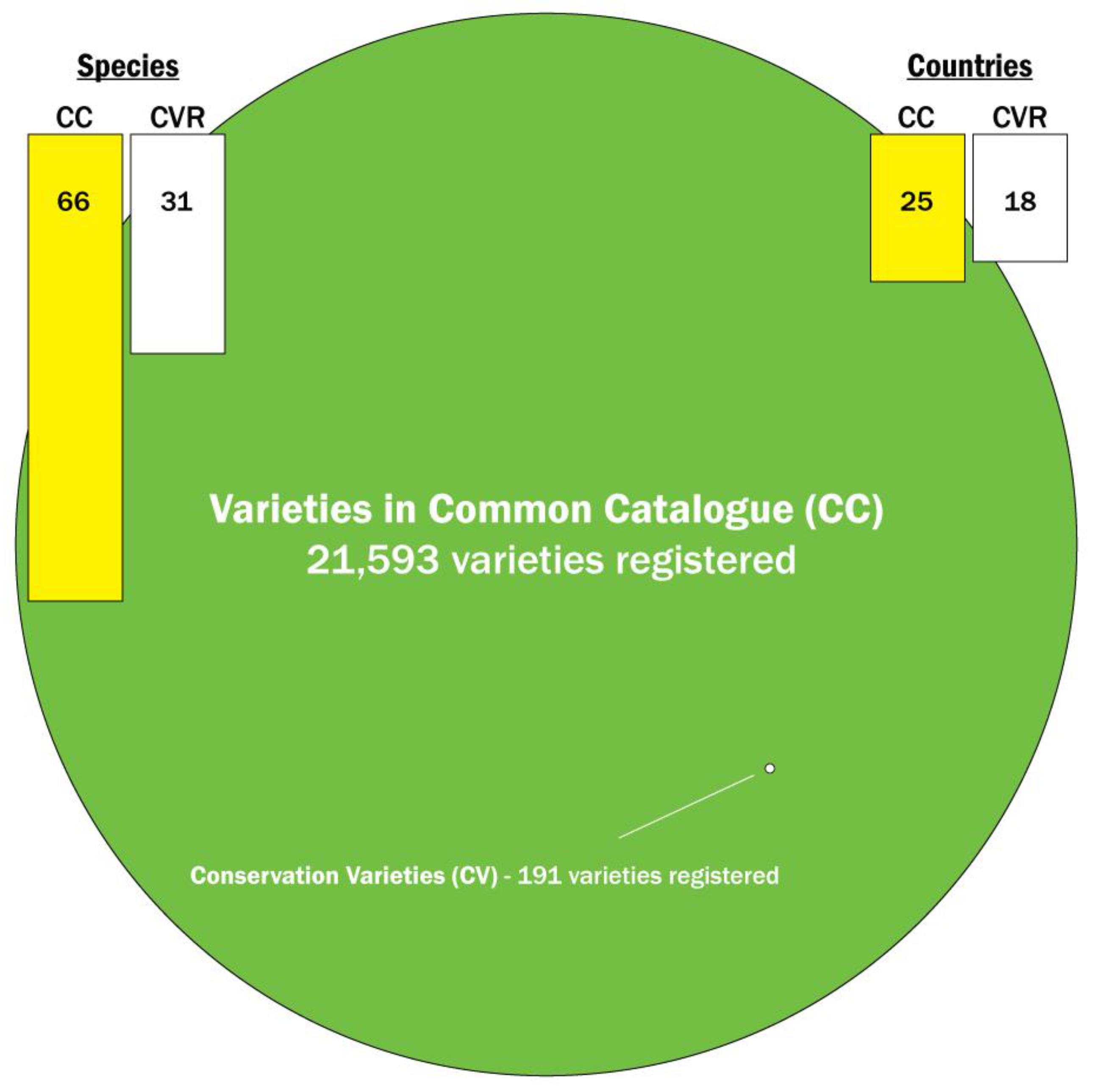
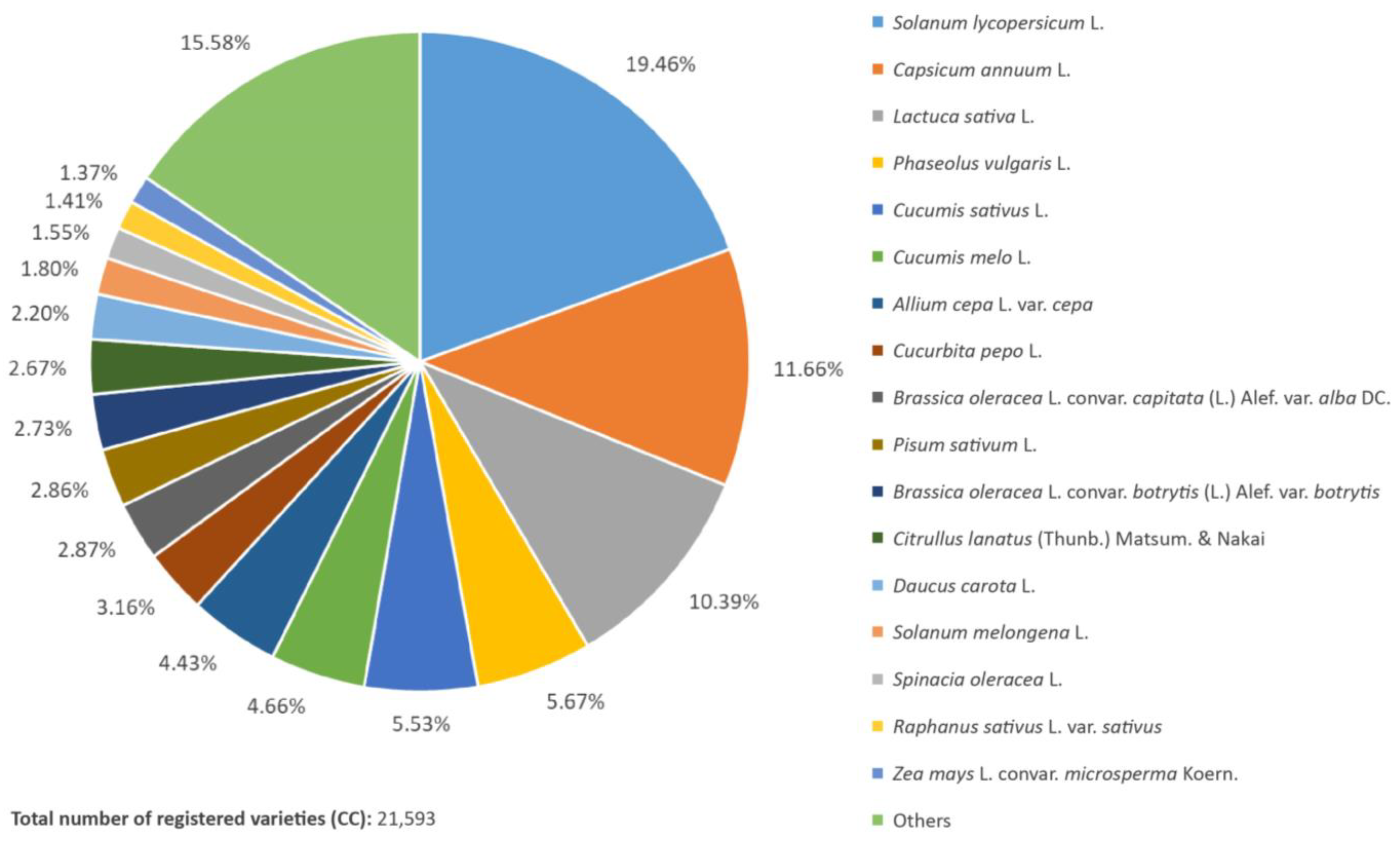
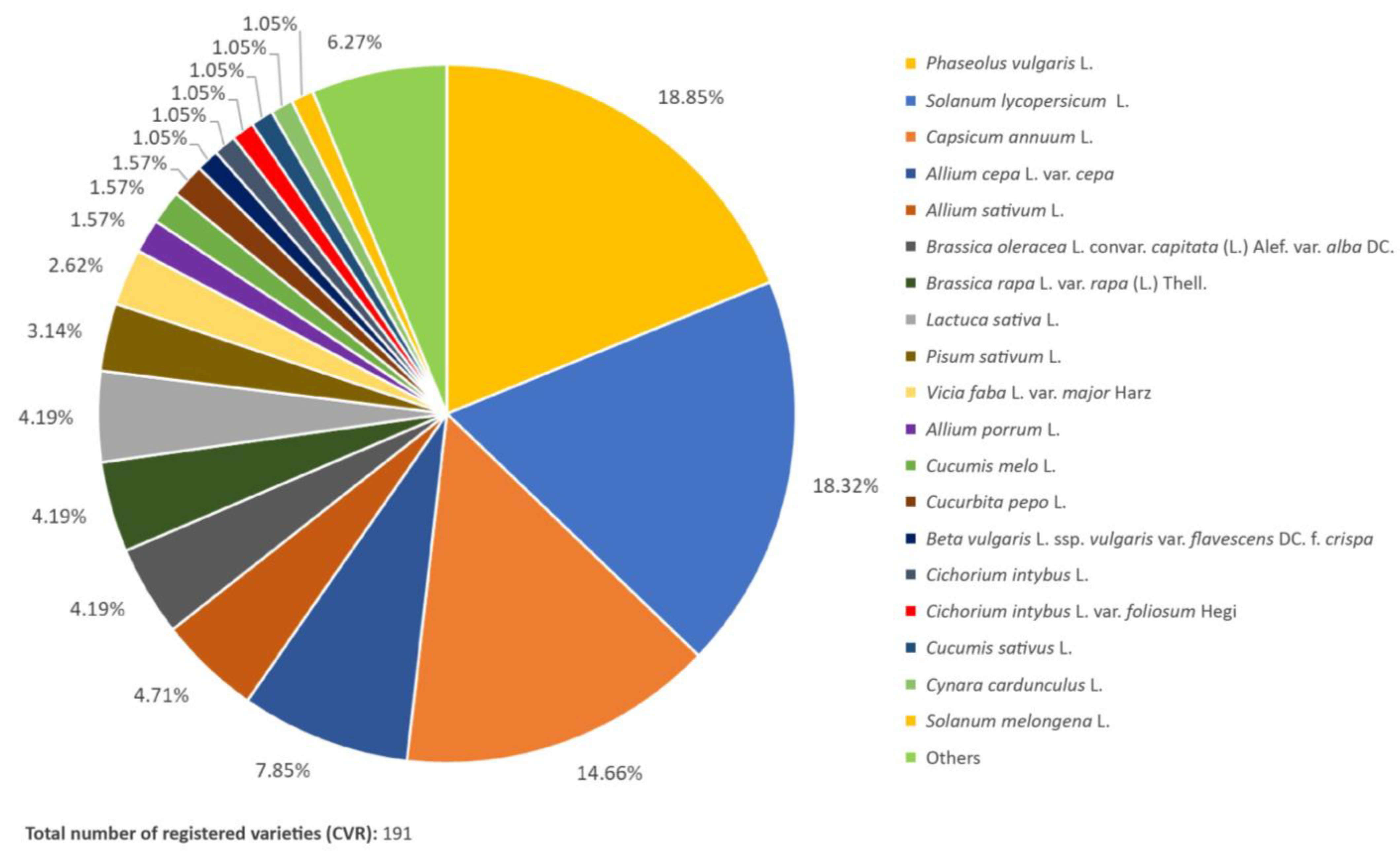
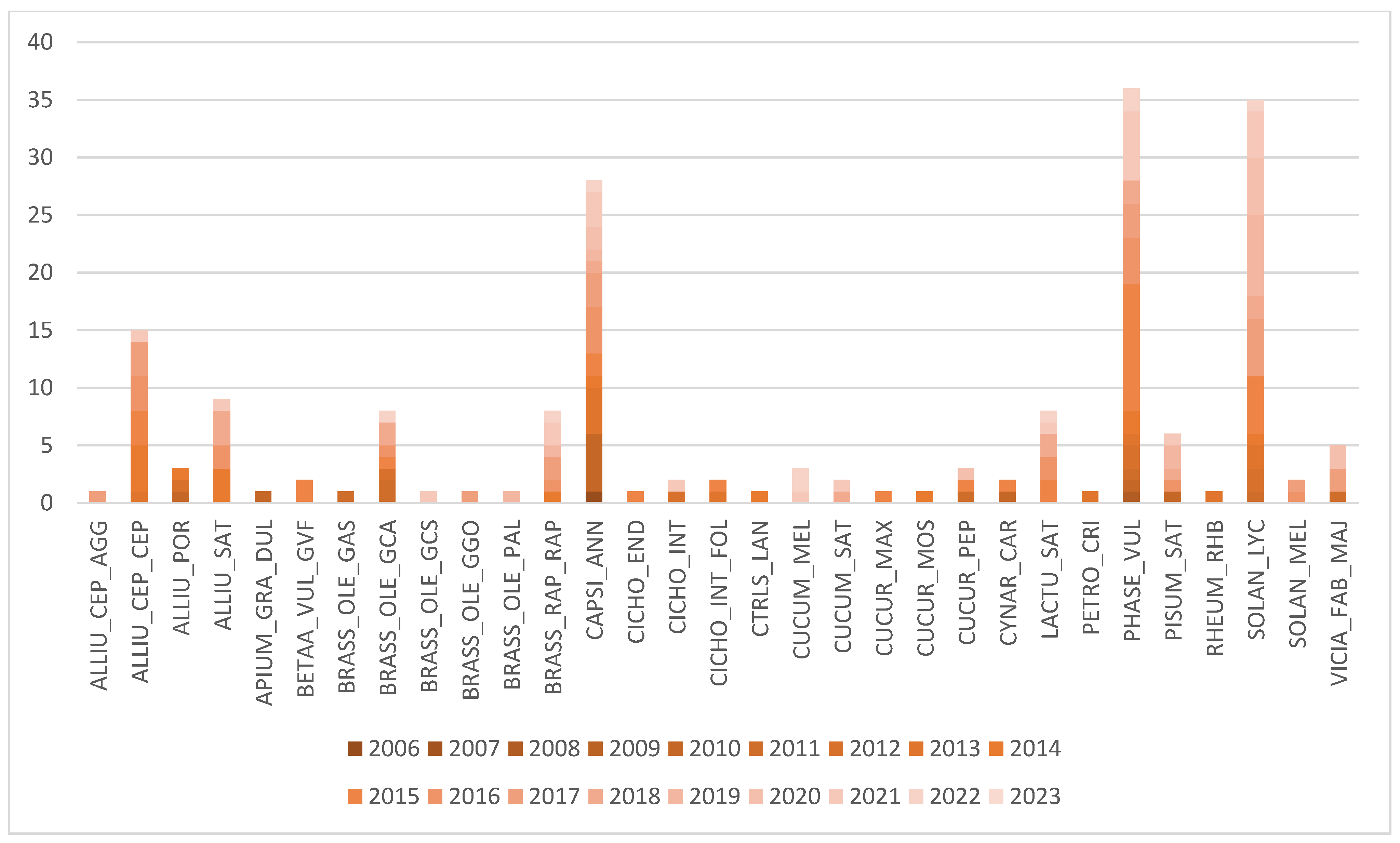
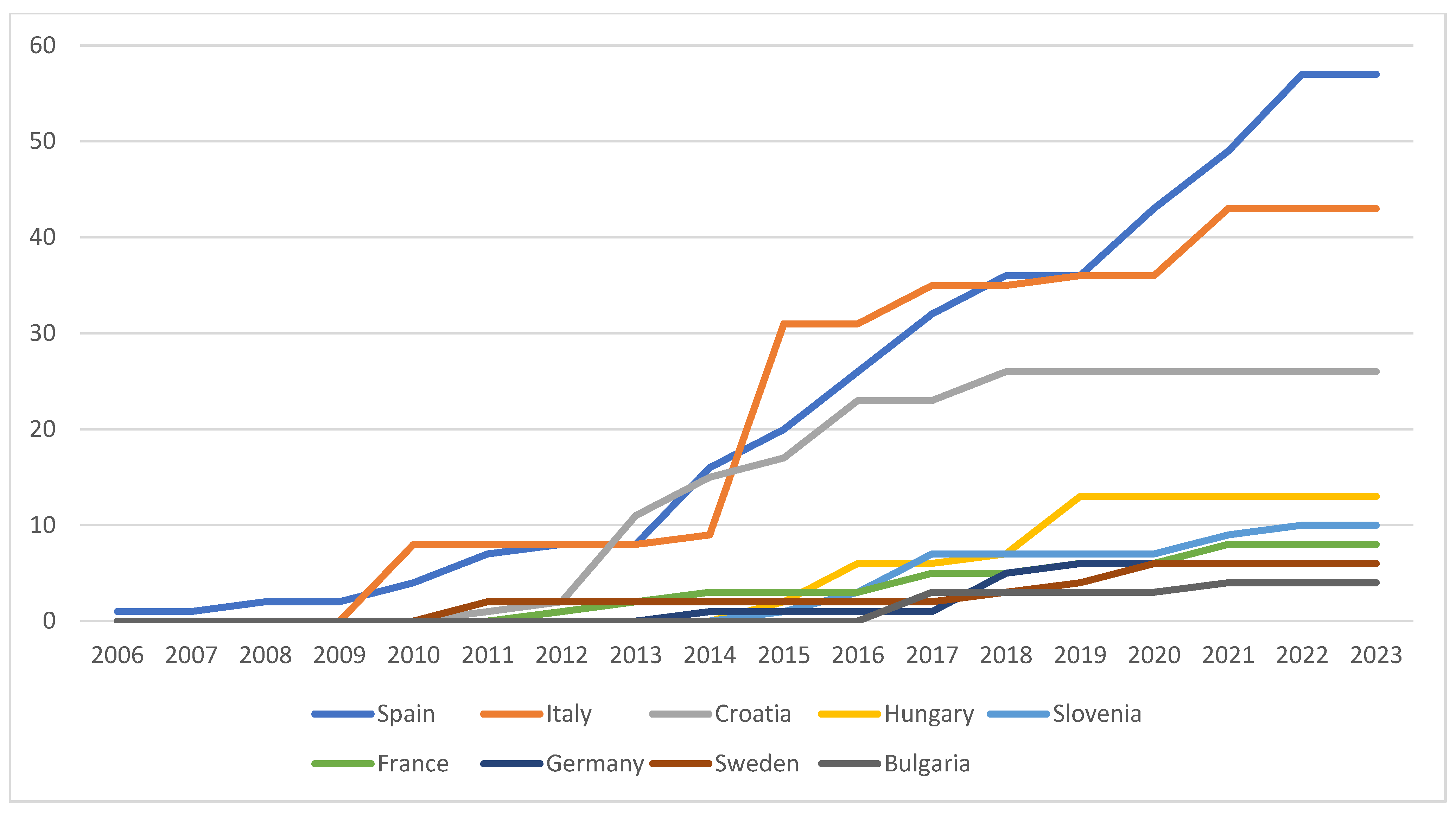
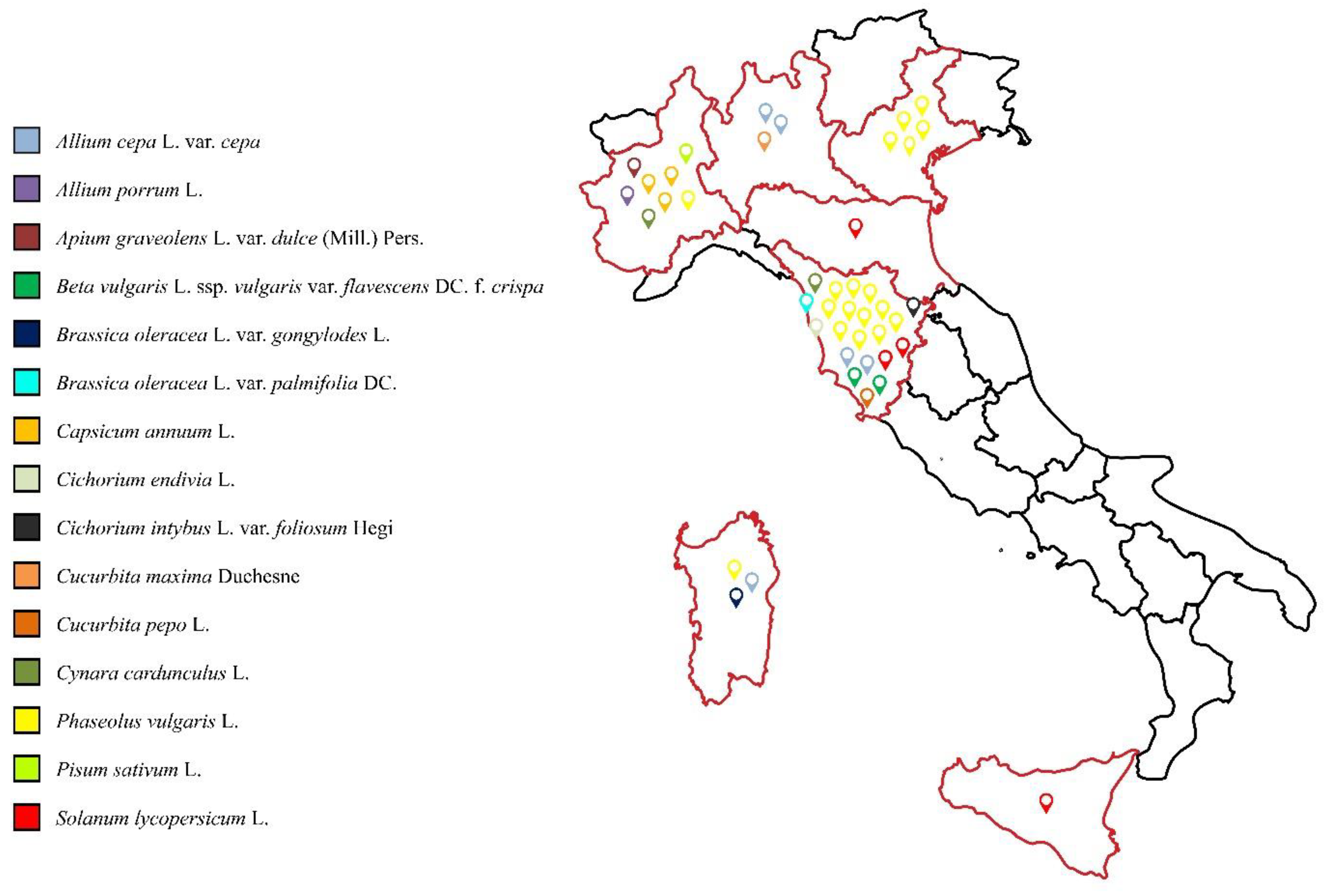
| Species List (UPOV Name) | No. of Conservation Varieties (CVR) | No. of Conservation Varieties (CVR) (%) | No. of Varieties (CC) | No. of Varieties (CC) (%) |
|---|---|---|---|---|
| Phaseolus vulgaris L. | 36 | 18.85% | 1224 | 5.67% |
| Solanum lycopersicum L. | 35 | 18.32% | 4202 | 19.46% |
| Capsicum annuum L. | 28 | 14.66% | 2517 | 11.66% |
| Allium cepa L. var. cepa | 15 | 7.85% | 956 | 4.43% |
| Allium sativum L. | 9 | 4.71% | 144 | 0.67% |
| Brassica oleracea L. convar. capitata (L.) Alef. var. alba DC. | 8 | 4.19% | 620 | 2.87% |
| Brassica rapa L. var. rapa (L.) Thell. | 8 | 4.19% | 122 | 0.56% |
| Lactuca sativa L. | 8 | 4.19% | 2243 | 10.39% |
| Pisum sativum L. | 6 | 3.14% | 618 | 2.86% |
| Vicia faba L. var. major Harz | 5 | 2.62% | 117 | 0.54% |
| Allium porrum L. | 3 | 1.57% | 161 | 0.75% |
| Cucumis melo L. | 3 | 1.57% | 1007 | 4.66% |
| Cucurbita pepo L. | 3 | 1.57% | 682 | 3.16% |
| Beta vulgaris L. ssp. vulgaris var. flavescens DC. f. crispa | 2 | 1.05% | 77 | 0.36% |
| Cichorium intybus L. | 2 | 1.05% | 60 | 0.28% |
| Cichorium intybus L. var. foliosum Hegi | 2 | 1.05% | 110 | 0.51% |
| Cucumis sativus L. | 2 | 1.05% | 1195 | 5.53% |
| Cynara cardunculus L. | 2 | 1.05% | 83 | 0.38% |
| Solanum melongena L. | 2 | 1.05% | 389 | 1.80% |
| Others | 12 | 6.00% | 5066 | 23.46% |
| Country | No. of Conservation Varieties (CVR) | No. of Conservation Varieties (CVR) (%) | No. of Varieties (CC) | No. of Varieties (CC) (%) |
|---|---|---|---|---|
| Spain | 57 | 29.84% | 1992 | 9.23% |
| Italy | 43 | 22.51% | 1909 | 8.84% |
| Croatia | 26 | 13.61% | 62 | 0.29% |
| Hungary | 13 | 6.81% | 1298 | 6.01% |
| Slovenia | 10 | 5.24% | 135 | 0.63% |
| France | 8 | 4.19% | 2880 | 13.34% |
| Germany | 6 | 3.14% | 621 | 2.88% |
| Sweden | 6 | 3.14% | 63 | 0.29% |
| Belgium | 4 | 2.09% | 299 | 1.38% |
| … | … | … | … | … |
| Netherlands | 1 | 0.52% | 8552 | 39.61% |
| … | … | … | … | … |
| Others | 14 | 7.33% | 3782 | 17.51% |
| Registration Date | N° of CVR Registrations | N° of CVR Registrations (Progressive) |
|---|---|---|
| 2006 | 1 | 1 |
| 2007 | 0 | 1 |
| 2008 | 1 | 2 |
| 2009 | 0 | 2 |
| 2010 | 10 | 12 |
| 2011 | 7 | 19 |
| 2012 | 7 | 26 |
| 2013 | 11 | 37 |
| 2014 | 15 | 52 |
| 2015 | 31 | 83 |
| 2016 | 19 | 102 |
| 2017 | 21 | 123 |
| 2018 | 14 | 137 |
| 2019 | 12 | 149 |
| 2020 | 10 | 159 |
| 2021 | 23 | 182 |
| 2022 | 9 | 191 |
| Exceptions | Restrictions |
|---|---|
| Free registration in the National Registers and not subject to any official examination if the information submitted in the application is sufficient | Conservation-variety seeds may only be marketed if they are produced and sold in the area of origin (with exemptions) |
| Adoption of specific DUS criteria | The number of seeds marketed must not exceed the limits set by the regulations |
| Exceptions to the varietal denomination scheme governed by Regulation 637/2009/EC | Obligation for producers to notify the relevant administration (region or autonomous province) of the quantity of seeds marketed |
| Exceptions to the minimum requirements for varietal purity | Requirement to demonstrate historical connection to the area of origin and degree of genetic erosion to apply for registration |
| Official inspections carried out retrospectively and through surveys | |
| Exemption from demonstration of possession of the requirements and professional knowledge of (i) mechanical production/selection techniques and (ii) seed- and plant-health regulations concerning the seed categories for which authorisation to produce is requested | |
| Right to direct local sales and right to free trade within the “National network of biodiversity of agricultural and food interest” |
| Species | Number of CVR Registrations | Number of CVR Registrations (%) |
|---|---|---|
| Allium cepa L. var. cepa | 5 | 11.63 |
| Allium porrum L. | 1 | 2.33 |
| Apium graveolens L. var. dulce (Mill.) Pers. | 1 | 2.33 |
| Beta vulgaris L. ssp. vulgaris var. flavescens DC. f. crispa | 2 | 4.65 |
| Brassica oleracea L. var. gongylodes L. | 1 | 2.33 |
| Brassica oleracea L. var. palmifolia DC. | 1 | 2.33 |
| Capsicum annuum L. | 3 | 6.98 |
| Cichorium endivia L. | 1 | 2.33 |
| Cichorium intybus L. var. foliosum Hegi | 1 | 2.33 |
| Cucurbita maxima Duchesne | 1 | 2.33 |
| Cucurbita pepo L. | 1 | 2.33 |
| Cynara cardunculus L. | 2 | 4.65 |
| Phaseolus vulgaris L. | 18 | 41.86 |
| Pisum sativum L. | 1 | 2.33 |
| Solanum lycopersicum L. | 4 | 9.30 |
| Name | Type of Maintainer | N° of Varieties Being Maintained | Region |
|---|---|---|---|
| AZIENDA AGRARIA SPERIMENTALE STUARD S.C.R.L. | Private (with connection to public research programme) | 1 | Emilia-Romagna |
| COMITATO CUSTODI DELLA BIODIVERSITA DI ALGHERO (CCBA) “LO REVELLI” | Committee, consortium or association | 2 | Sardinia |
| CONSORZIO PER LA TUTELA DEL FAGIOLO DI LAMON | Committee, consortium or association | 5 | Veneto |
| CONSORZIO PRODUTTORI CIPOLLA DI VOGHERA | Committee, consortium or association | 1 | Lombardy |
| CRAB—CENTRO DI RIFERIMENTO PER L’AGRICOLTURA BIOLOGICA | Public | 1 | Piedmont |
| CRESO—CONSORZIO RICERCA E SVILUPPO PER L’ORTIFRUTTICOLTURA PIEMONTESE | Committee, consortium or association | 6 | Piedmont |
| DIPARTIMENTO DI SCIENZE AGRARIE, FORESTALI E ALIMENTARI UNIVERSITA DEGLI STUDI DI TORINO | Public | 1 | Piedmont |
| GARGINI SEMENTI DI ALESSANDRO GARGINI & GIULIO GODI SNC | Seed company | 21 | Tuscany |
| Not available | Not available | 5 | Lombardy (2), Tuscany (1), Sardinia (1), Sicily (1) |
| Species | Conservation Variety | IT Region (1) | Available Area for Conservation Variety (ha) (2) | Cultivated Area for Species (ha) (3) | Available Area for Conservation Variety (%) (4) |
|---|---|---|---|---|---|
| Allium cepa L. var. cepa | Dorata di Voghera | Lombardy | 40 | 333 | 12.01% |
| Allium cepa L. var. cepa | Rossa di Breme | Lombardy | 40 | 333 | 12.01% |
| Allium cepa L. var. cepa | Mitja Valmella | Sardinia | 40 | 122 | 32.79% |
| Allium cepa L. var. cepa | Rossa a fiasco | Tuscany | 40 | 187 | 21.39% |
| Allium cepa L. var. cepa | Rossa massese | Tuscany | 40 | 187 | 21.39% |
| Allium porrum L. | Di Cervere | Piedmont | 20 | 47 | 42.55% |
| Apium graveolens L. var. dulce (Mill.) Pers. | Dorato Rissone | Piedmont | 10 | 18 | 55.56% |
| Beta vulgaris L. ssp. Vulgaris var. flavescens DC. f. crispa | Livornese da taglio | Tuscany | 20 | 186 | 10.75% |
| Beta vulgaris L. ssp. Vulgaris var. flavescens DC. f. crispa | Verde da taglio lucchese | Tuscany | 20 | 186 | 10.75% |
| Brassica oleracea L. var. gongylodes L. | Colatronxo | Sardinia | 40 | 24 | >100.00% |
| Brassica oleracea L. var. palmifolia DC. | Braschetta | Tuscany | 40 | 74 | 54.05% |
| Capsicum annuum L. | Corno di Carmagnola | Piedmont | 40 | 119 | 33.61% |
| Capsicum annuum L. | Cuneo | Piedmont | 40 | 119 | 33.61% |
| Capsicum annuum L. | Quadrato di Carmagnola | Piedmont | 40 | 119 | 33.61% |
| Cichorium endivia L. | Tardiva lucchese | Tuscany | 10 | 39 | 25.64% |
| Cichorium intybus L. var. foliosum Hegi | Del Marzocco | Tuscany | 40 | 178 | 22.47% |
| Cucurbita maxima Duchesne | Cappello da prete mantovana | Lombardy | 40 | n.a. | n.a. |
| Cucurbita pepo L. | Mora pisana | Tuscany | 20 | 386 | 5.18% |
| Cynara cardunculus subsp. scolymus (L.) Hayek | Gobbo di Nizza Monferrato | Piedmont | 40 | n.a. | n.a. |
| Cynara cardunculus subsp. scolymus (L.) Hayek | Pieno inerme lucchese | Tuscany | 40 | 657 | 6.09% |
| Phaseolus vulgaris L. | Bianco di Bagnasco | Piedmont | 40 | 984 | 4.07% |
| Phaseolus vulgaris L. | Gioghedda | Sardinia | 40 | 87 | 45.98% |
| Phaseolus vulgaris L. | Aquila | Tuscany | 40 | 306 | 13.07% |
| Phaseolus vulgaris L. | Diecimino | Tuscany | 40 | 306 | 13.07% |
| Phaseolus vulgaris L. | Fico di Gallicano | Tuscany | 40 | 306 | 13.07% |
| Phaseolus vulgaris L. | Garfagnino | Tuscany | 40 | 306 | 13.07% |
| Phaseolus vulgaris L. | Giallorino della Garfagnana | Tuscany | 40 | 306 | 13.07% |
| Phaseolus vulgaris L. | Malato | Tuscany | 40 | 306 | 13.07% |
| Phaseolus vulgaris L. | Mascherino | Tuscany | 40 | 306 | 13.07% |
| Phaseolus vulgaris L. | Rosso di Lucca | Tuscany | 40 | 306 | 13.07% |
| Phaseolus vulgaris L. | Schiaccione di Pietrasanta | Tuscany | 40 | 306 | 13.07% |
| Phaseolus vulgaris L. | Stortino di Lucca | Tuscany | 40 | 306 | 13.07% |
| Phaseolus vulgaris L. | Zolfino | Tuscany | 40 | 306 | 13.07% |
| Phaseolus vulgaris L. | Calonega | Veneto | 40 | 958 | 4.18% |
| Phaseolus vulgaris L. | Canalino | Veneto | 40 | 958 | 4.18% |
| Phaseolus vulgaris L. | Spagnolit | Veneto | 40 | 958 | 4.18% |
| Phaseolus vulgaris L. | Spagnolit nano | Veneto | 40 | 958 | 4.18% |
| Phaseolus vulgaris L. | Spagnolo | Veneto | 40 | 958 | 4.18% |
| Pisum sativum L. | Quarantin di Casalborgone | Piedmont | 40 | 444 | 9.01% |
| Solanum lycopersicum L. | Riccio di Parma | Emilia Romagna | 40 | 25,505 | 0.16% |
| Solanum lycopersicum L. | Pizzutello dell’Agro Ericino | Sicily | 40 | 12,525 | 0.32% |
| Solanum lycopersicum L. | Canestrino di Lucca | Tuscany | 40 | 2714 | 1.47% |
| Solanum lycopersicum L. | Pisanello | Tuscany | 40 | 2714 | 1.47% |
Disclaimer/Publisher’s Note: The statements, opinions and data contained in all publications are solely those of the individual author(s) and contributor(s) and not of MDPI and/or the editor(s). MDPI and/or the editor(s) disclaim responsibility for any injury to people or property resulting from any ideas, methods, instructions or products referred to in the content. |
© 2024 by the authors. Licensee MDPI, Basel, Switzerland. This article is an open access article distributed under the terms and conditions of the Creative Commons Attribution (CC BY) license (https://creativecommons.org/licenses/by/4.0/).
Share and Cite
Didonna, A.; Bocci, R.; Renna, M.; Santamaria, P. The Conservation Varieties Regime: Its Past, Present and Future in the Protection and Commercialisation of Vegetable Landraces in Europe. Horticulturae 2024, 10, 877. https://doi.org/10.3390/horticulturae10080877
Didonna A, Bocci R, Renna M, Santamaria P. The Conservation Varieties Regime: Its Past, Present and Future in the Protection and Commercialisation of Vegetable Landraces in Europe. Horticulturae. 2024; 10(8):877. https://doi.org/10.3390/horticulturae10080877
Chicago/Turabian StyleDidonna, Adriano, Riccardo Bocci, Massimiliano Renna, and Pietro Santamaria. 2024. "The Conservation Varieties Regime: Its Past, Present and Future in the Protection and Commercialisation of Vegetable Landraces in Europe" Horticulturae 10, no. 8: 877. https://doi.org/10.3390/horticulturae10080877
APA StyleDidonna, A., Bocci, R., Renna, M., & Santamaria, P. (2024). The Conservation Varieties Regime: Its Past, Present and Future in the Protection and Commercialisation of Vegetable Landraces in Europe. Horticulturae, 10(8), 877. https://doi.org/10.3390/horticulturae10080877








